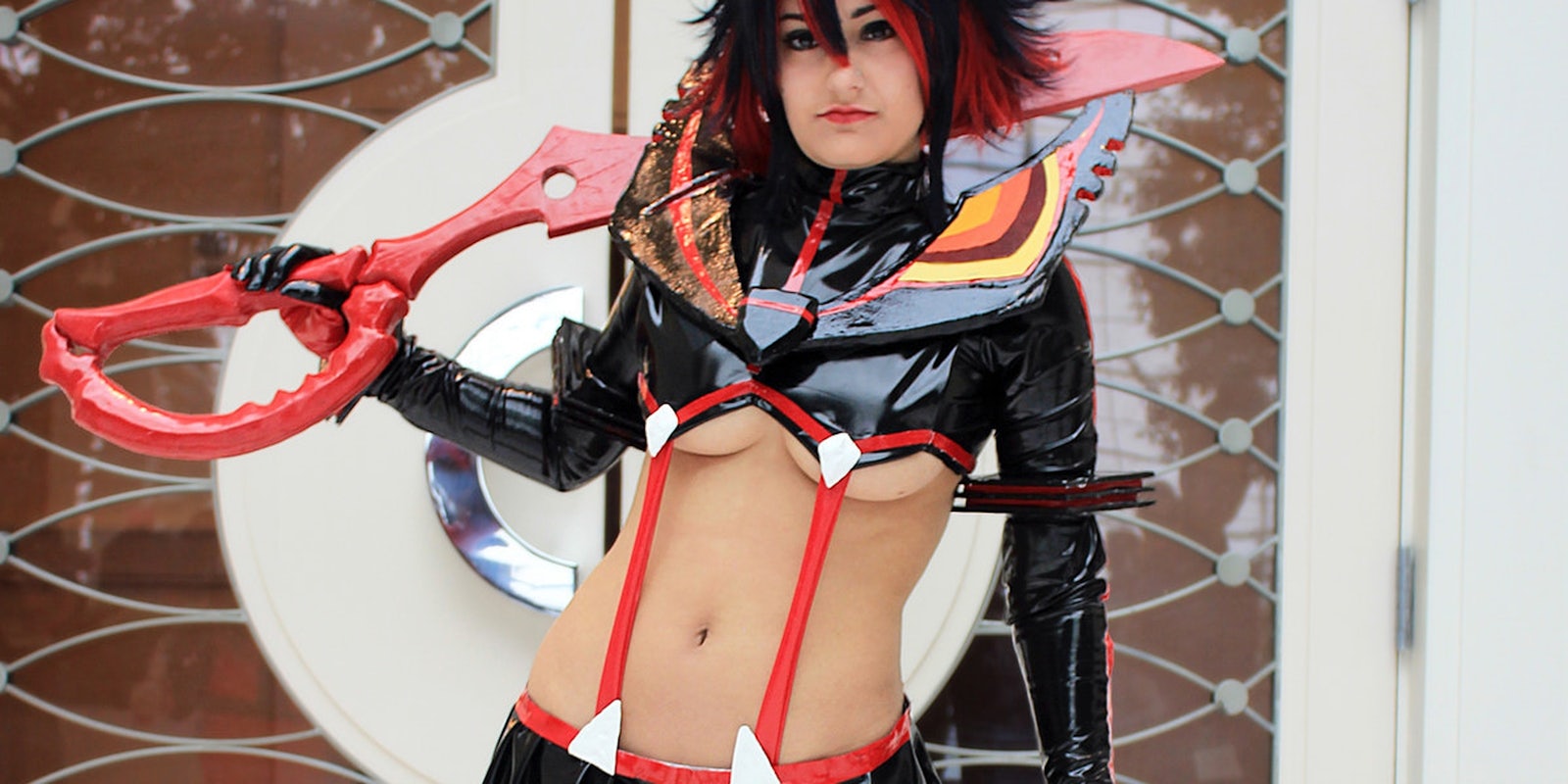If you’re an anime fan, chances are you’ve gotten into a Kill La Kill-related argument recently. The wild ride of the first season just ended, leaving fans and critics totally polarized about whether KLK is treasure or trash.
Its critics argue that Kill La Kill is misogynist. It’s an extremely easy argument to make. The series is full of blatant fanservice and gratuitous shots of T&A that make even typical skimpy superhero outfits on female comic book characters seem tame by comparison.
So why do so many female, not to mention feminist, anime fans love it?
Here’s an easy way to understand how mixed-up people are about Kill La Kill. On the typically female-dominated, proto-feminist, anti-objectification Tumblr, one user posted a controversial but popular argument that the show is actually about female empowerment. When typically male-dominated bastion of “men’s rights” Reddit got hold of it, they summarily rejected the argument that KLK was anything but fanservice.
Tumblr defending a show while Reddit calls it sexist? What is this madness?

Photo via Blog of the Rising Sun
Ostensibly, KLK is about a girl fighting to avenge the death of her father while taking on a formidable opponent and leader of a massive school. On another level, it’s about dangerous, sentient fighter suits and their wearers. On another, it’s about classic retro-style fight sequences:
But ask most people, and they’ll tell you that Kill La Kill is really about boobs.
We’re not kidding. Kill La Kill boasts more fanservice per square inch (of bare womanly skin) than we’ve seen outside straight-up erotica. Consider all images from here on out NSFW:
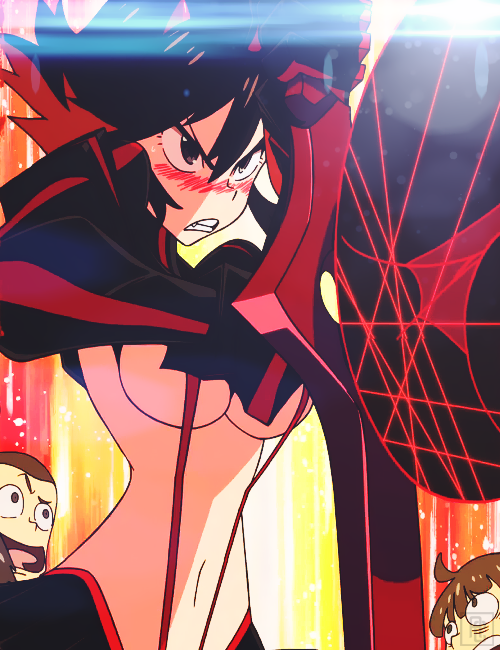
Photo via Blog of the Rising Sun
“Kill La Kill is, throughout, a show where the sexual violation of teenaged girls is inevitable and morally neutral,” Tumblr user marxism-leninism-utenaism wrote recently. “This is a misogyny which is built into the conceptual framework of the narrative, its character design, marketing, and visual framing. It is The Bad Anime and I’m sad that people like it.”
This “Bad Anime,” however, is the hit of the year, spawning endless debates and intellectual conversation about the multiple levels on which it functions metaphorically and allegorically. Even as Kill La Kill is sparking outrage over its misogyny, it’s summing up the anime fan’s universal dilemma:
Is this series I like deep and meaningful? Or is it really just about kinky, subjugating sexual fantasies?
This is the “battle armor” of the main protagonist of Kill La Kill, Ryuko. As you can see, it’s, uh, not really made for protection.
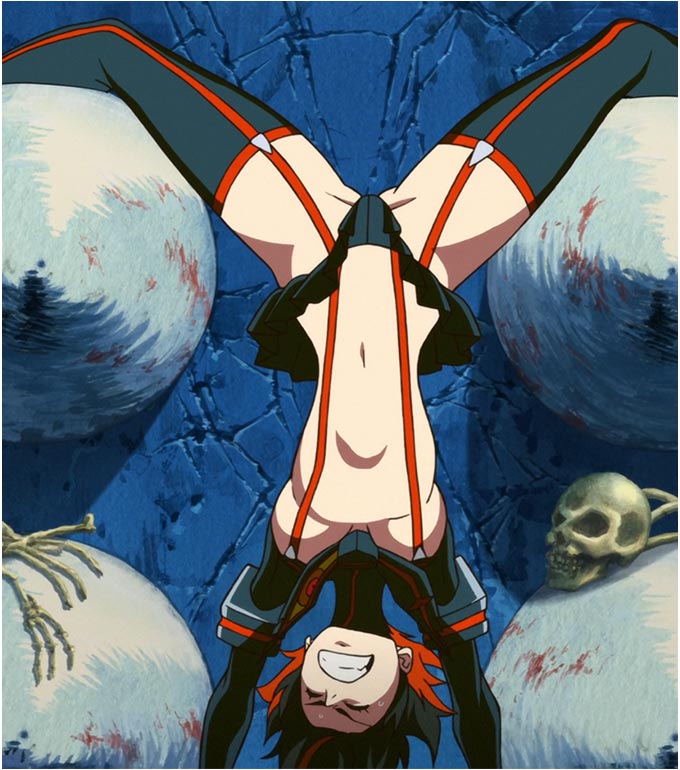
Photo via Animenz
It does, however, look a lot cooler in action, as you can tell from this moment, taken from one of KLK’s shounen-manga-inspired fight sequences:
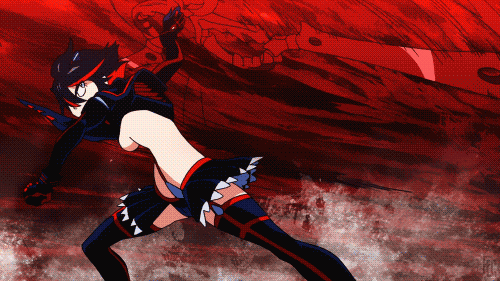
GIF by goesinmybutt/Tumblr
The suit Ryuko’s wearing—or isn’t wearing, depending on your perspective—is the most contentious thing about Kill La Kill. For one thing—well, just look at it. Ryuko’s outfit is so over-the-top that when a cosplayer pulled it off at a Singapore anime convention last fall, a horrified onlooker actually summoned the police.
But this particular suit is a lot more than just an excuse for fanservice. Narratively, not only does it form part of the series’ core conflict, but it quite literally exists to empower Ryuko through humiliation and discomfiture. [Spoilers ahead!] It’s made for her by her father, but it’s also a sentient, male suit that literally clamps on to her and forces her to be the Seymour to its Audrey II. When she gives it her blood, it responds by stripping her down and giving her super-strength, transforming her into a formidable fighter.
And because naturally all this is an allegory for female de-flowering, her father gave the suit a name that means “blood.”
Back in October, the anonymous Dreamwidth forum wankgate had an all-out brawl over KLK shortly after its controversial third episode aired, in which we learn the backstory of Ryuko and her suit. One anonymous user articulately explained objections to the suit:
the problem isn’t that the protagonist wears a skimpy outfit while the audience and other characters drool over it, it was that the outfit was foisted on her in a scenario that was, for lack of a better phrase, rapey as hell. … while the intended message of episode three was probably something along the lines of, “i will no longer let this unwanted attention make me feel dirty and ashamed of myself”, the message that came across was,”i will accept this situation where i was sexually violated and will continue to be sexually violated, but it’s okay, i just needed some time to get used to my creepy rape suit.”
Frankly, no one wouldn’t blame you if you tuned out at this point, but if you did you’d miss out on all the rampant sexual objectification and additional humiliation that comes after Ryuko puts on the suit. Kill La Kill’ s plot involves Ryuko eventually coming to accept and feel empowered by the bloodthirsty rape suit. But it also means she endures a lot of gawking (both from the men onsceen and us as viewers), none of which she enjoys.
To top it all off, while Ryuko endures the mortification associated with the suit, it seems at first that her primary opponent, Satsuki, is meant to be an empowered version of a woman who actually wants to wear the suit. Her suit’s name literally translates to “purity.” Here’s what hers looks like:
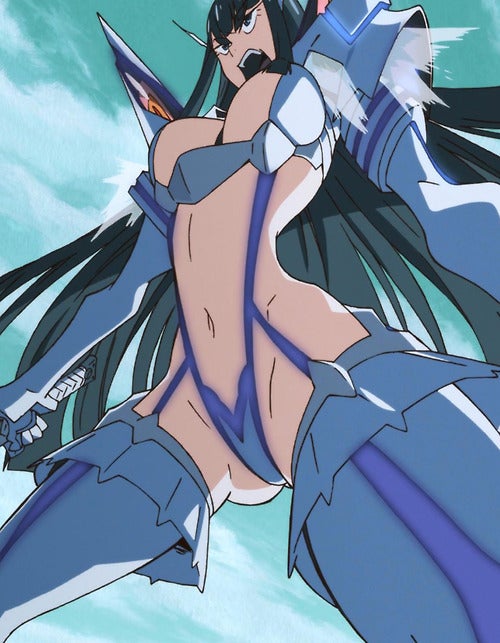
Photo via Eschergirls/Tumblr
This pose, by the way, was used by feminist Tumblr eschergirls to illustrate how Kill La Kill offers examples what’s sarcastically known as “strong superhero pose“—a way of defying physical reality when drawing women so both their boobs and butts are showing.
“I’ve gotten Kill La Kill submitted so much,” wrote the moderator when she posted the picture above. Another similar Tumblr, repair-her-armor, usually attempts to remedy the superhero outfits of women underserved by their sexist artistic depictions; but when they tackled Kill La Kill, they came away with the conclusion that sentient skin-tight battle armor that insists on groping you was “irreparable.”
It’s crucial to note that Satsuki seeks out her version of the suit and uses it willingly in order to augment her fighting skills. Her use of it is meant to be empowering, and its the way she wears it—without shame—that prompts Ryuko to accept her own suit.
But ultimately, it’s arguable that Satsuki’s choice to wear the suit is undermined as well. Near the end of the first season, she’s revealed to be a victim of child sexual abuse. From this vantage point, Kill La Kill‘s first-season narrative offers a pretty blatant version of the oft-critiqued idea that for a woman to find her inner strength, she neends to be subjugated and victimized and sexually assaulted first. It’s a pretty nasty framework, and one that’s turned off a lot of Kill La Kill viewers.
Yet despite all of this arguable misogyny, Kill La Kill fans of all genders not only stick around but love the series.
What can they possibly be watching for? A lot, as it turns out. There’s so much layered symbolism and metaphor in Kill La Kill that fans have extrapolated numerous readings of the show, some more obvious than others, to talk about what the story is doing the rest of the time, when it’s not showing you boobs and v-shots. Here’s just a brief list of the reason Kill La Kill‘s fanbase raves about it:
Kill La Kill has lots of talent…
Kill La Kill debuted last fall to massive hype just as the buzz for Attack on Titan was finally starting to die down. Most of the hype had to do with the creative team behind it. It comes from Trigger, the studio that brought you last year’s hit short Little Witch Academia. The director, Hiroyuki Imaishi, cut his teeth as a lead animator for a series you might have heard of called Neon Genesis Evangelion. KLK’s creators previously worked together on the popular and award-winning mecha anime Gurren Lagann. There’s some serious talent behind Kill La Kill, too much to write it off as just another bit of ecchi fanservice.
…and lots of homages
In a fan-translated interview with the Japanese magazine New Life, Imaishi indicated that the idea for KLK had arisen after the creators thought about translating Gurren Lagann‘s fighting suits to a female-led society in a traditional battle manga. Not only does Kill La Kill reference numerous classic shounen manga poses and design elements, but it’s chock full of homages to iconic magical girl transformation sequences and battle scenes like those found in Utena. Recently at Anime Boston, Space Dandy writer Dai Sato spoke repeatedly of Kill La Kill as one of a number of shows heralding a recent wave of nostalgia for “golden age” anime with its elaborate, stylized fighting sequences and layered references to anime greats.
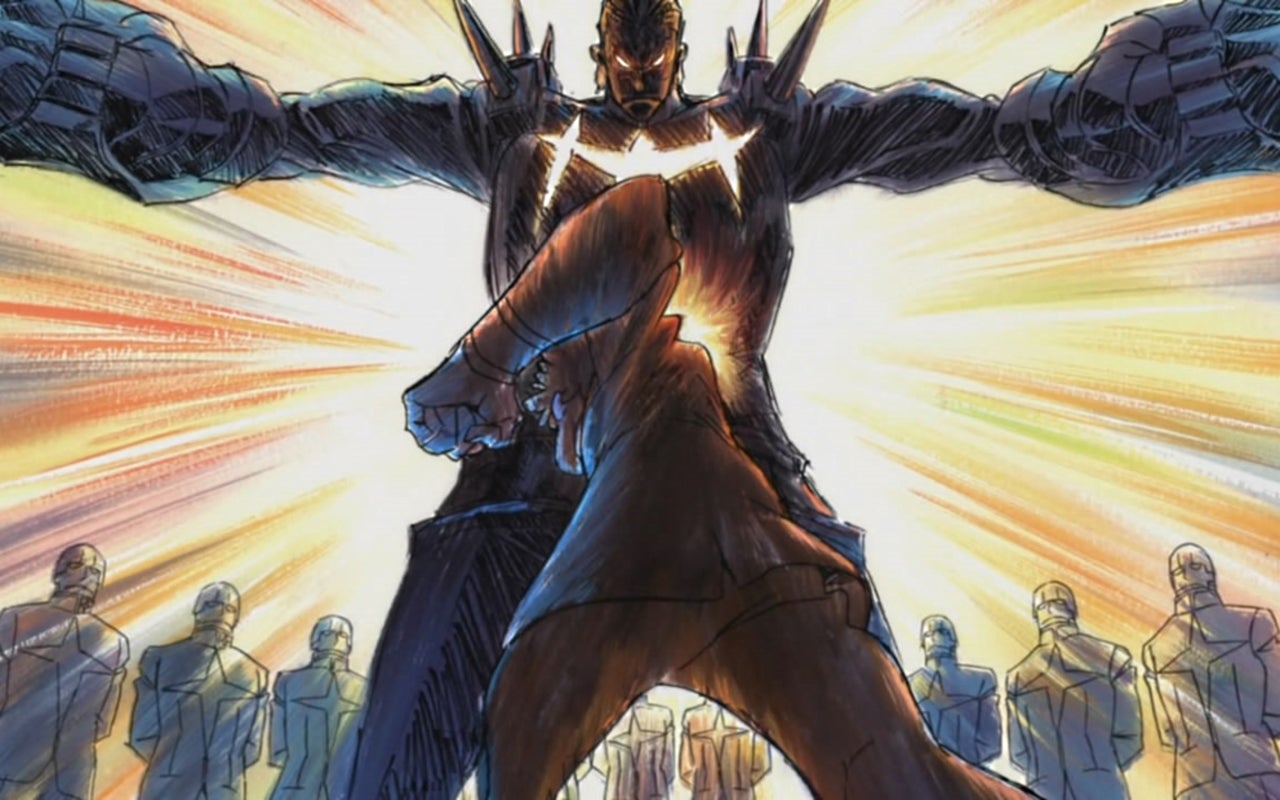
Photo via Tofugu
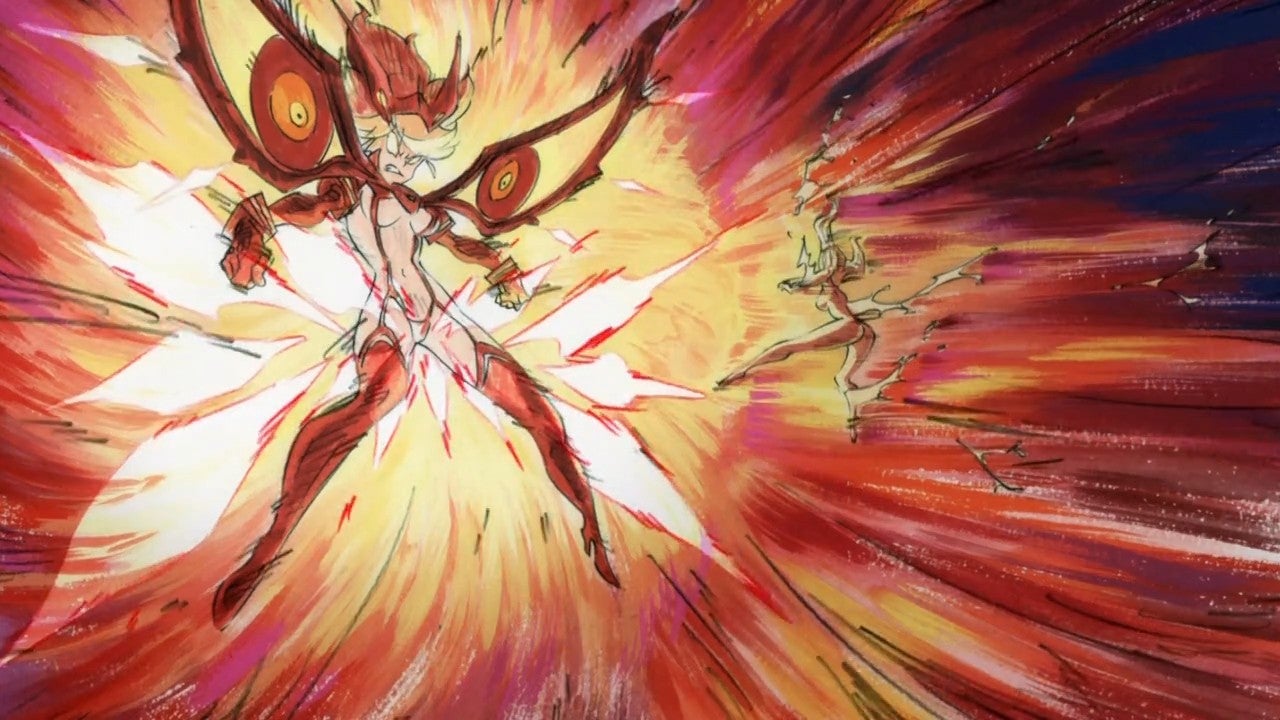
Photo via llrosariovampirell/Tumblr
Kill La Kill is exploring fashion as the literal weaponry of feminity…
Perhaps the strongest way in which the narrative actively resists being slotted into a box marked “gratuitous fanservice” is the way in which it actively focuses its plot on the way its female characters react to and contend with the experience of being looked at and forced to strip down in order to fight. In fact, the Japanese title, Kiru la Kiru, is a three-way pun on the meanings “cut” and “wear,” which are both pronounced “kiru.” On one level, the title means Cut to Wear, a reference to the suit’s skin-grasping powers. On another level, it’s an imperative: Ryuko literally has to cut away at her clothes to wear her outfit as a weapon. At one point she proclaims, “I was rejecting you out of embarrassment!” as she finally “masters” the suit and its potential as a weapon.
Naturally, fans have taken the empowered fashion element and run with it, as in these fabulous fanart GIFs by barfingprince, which depict all of the fashion transformations the two main characters undergo during the series:
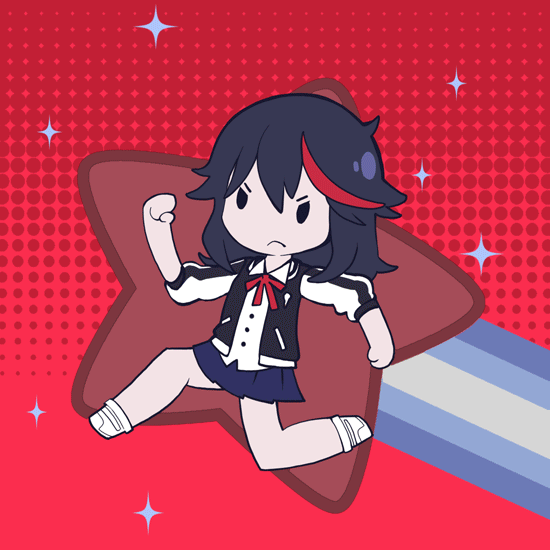
Illustration by barfingprince/Tumblr

Illustration by barfingprince/Tumblr
…and fashion as Fascism
Kill La Kill‘s title also masks another critique of itself—the idea that the words Cut/Wear are synonymous. In Kill La Kill, empowered femininity means mastering the displays of sexuality demanded by fashion. But this idea of fashion is also aligned with the goals of fascism, another pun the series frequently makes. Fashion is aligned with Fascism in numerous ways. Satsuki’s school is more like a national police force in training. At regular intervals throughout KLK, students are seen studying the rise of Hitler, all while they go about their lives with faceless unity, wearing military-styled school uniforms:

Photo via formeinfullbloom/Wordpress
Students also spy on each other and institute sophisticated surveillance mechanisms. One student declares herself a member of the Committee for “Trap Development,” designed to ensnare other students into making mistakes or getting kicked out of school. In the midst of all this, Satsuki heads the school regime, ruling with Orwellian slogans (Fear is Freedom! Subjugation is Liberation!) and dividing the school’s society into a meritocracy at which the lowest rung, the underachievers and failures, are utter social outcasts. Satsuki’s suit represents the extremes to which those who seek power above all costs are prepared to go. The show, at least on one-level, seems to be equating the sexual “purity” of the suit to the dangerous ideals of fascist regimes. In the story, the sentient suits are so dangerous that a number of characters form a community to try and actively fight the suits. The community’s name? Nudist Beach, a nudist colony so far populated by naked men who’ve broken away from the social ideals of Satsuki’s fascist state… and away from clothes.
It also has loads of political commentary—mixed with folklore
Kill La Kill doesn’t just take on fascism as a concept, but global response to it. Anime fandom academics Charles Dunbar and Kit Flowerstorm argue convincingly that Kill La Kill‘s narrative arc is a political allegory for Japanese-U.S. relations, and the lessons Japan needs to learn in order to maintain its autonomy and survive into the future. The post-war American occupation of Japan identified “State Shinto” as a problem and set out to dismantle it, essentially dividing church and state in Japan for the first time in decades. A crucial part of state-led Shinto worship centered around Ameterasu, the Sun God. The narrative of Kill La Kill very clearly depicts Ameterasu as Satsuki, backed by all the authority of the state:

GIF via killlakillgifs/Tumblr
But as we know, state-run Shinto couldn’t outlast the 20th century. Over the course of Kill La Kill‘s narrative, we begin to realize that Satsuki as Ameterasu will have similar trouble maintaining her power in the face of the new outside influence of Ryuko, who represents the rogue demon of Shinto and Japanese folklore, the oni.
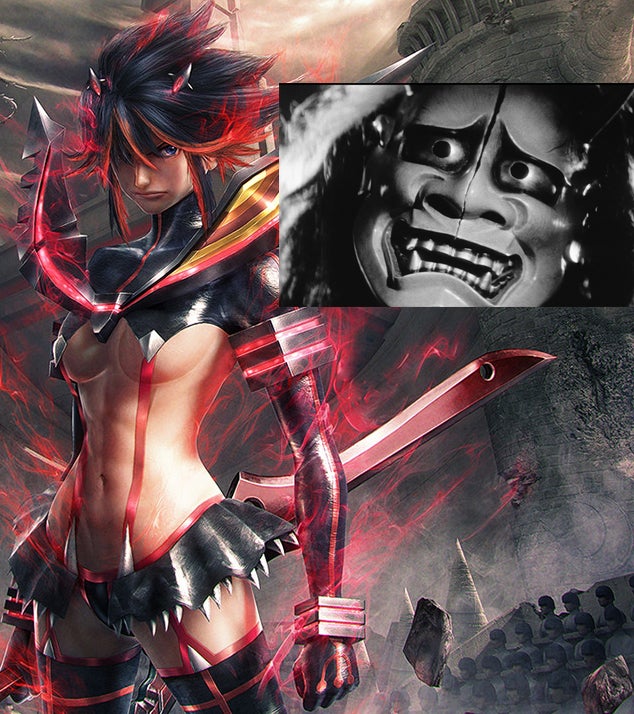
Illustration by Tani; Screengrab via Diabolique
Like oni, Ryuko has horns, undergoes a physical transformation, and exploits increased physical capabilities. And just as Japanese oni lore emphasizes the demon’s disenfranchisement, Ryuko is likewise an outsider whose upbringing and removal from the social system of Satsuki’s school are causes for concern and catalysts for upheaval. By the same token, the U.S. post-war occupation brought with it its own challenges, leading to the subsequent creation of the modern state of Japan. Kill La Kill‘s allegorical political narrative seems clear.
But ultimately, maybe it’s about family. Or just about subverting all that fanservice?
On former Daily Dot reporter Lauren Orsini’s blog, Otaku Journalist, a guest columnist named Grant summed up his reading of Kill La Kill:
The story of Kill La Kill thus far has been the story of two girls exploring what their family ties mean to them and how they react to developing a fuller understanding of their relationship with their parents and their parents’ legacies.
Developments in the latter half of the season would seem to bear out this reading; especially when you consider that “blood ties” take on a whole new meaning when you’re bound to a blood-guzzling skin suit made of “life fibers.”
Another interesting reading argues that the work of KLK is actually to undo the harm perpetuated by the “cute” eroticism of traditional ecchi—another reading that gains an interesting boost from the series finale. Moreover, these illustrate just how many different ways there are to read the narrative of Kill La Kill.
Ultimately, as alienating as many viewers have found the misogyny in Kill La Kill, it’s difficult to write off the series, with its mix of the bizarre, baudy, and beautiful, as just another sexist contribution to the wide world of dirty animation.
But then again, when it comes to the things we value in media, what’s on Kill La Kill‘s surface—boobs and fanservice—might unfortunately be what matters most.
Photo via greyloch/Flickr; CC-BY-SA-2.0

